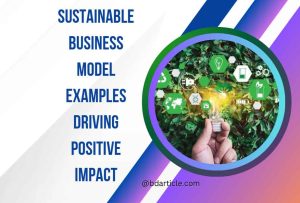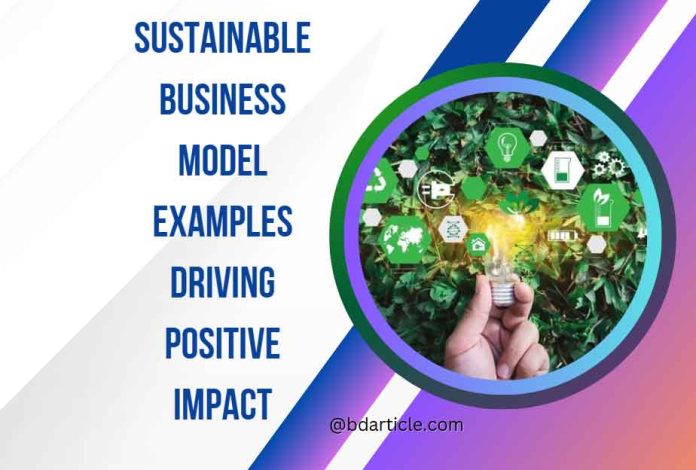Sustainable business model examples are reshaping industries by integrating profitability with environmental and social responsibility. As businesses face growing pressure to address climate change, resource scarcity, and social inequality, these models have emerged as a powerful way to balance economic success with long-term sustainability.

By adopting practices that align with the principles of sustainability, companies can foster innovation, enhance brand loyalty, and create value for stakeholders while minimizing negative environmental impacts. We explore various sustainable business model examples, their impact, and how they are driving positive change across industries.
Understanding Sustainable Business Models
A sustainable business model incorporates strategies that prioritize environmental stewardship, social equity, and economic growth. Unlike traditional models that often emphasize short-term gains, these frameworks focus on long-term value creation.
Key characteristics of sustainable business models include:
- Resource Efficiency: Reducing waste and optimizing the use of natural resources.
- Circularity: Emphasizing reuse, recycling, and regeneration.
- Social Responsibility: Supporting fair labor practices, diversity, and community engagement.
These models align with the triple bottom line approach: people, planet, and profit.
Sustainable Business Model Examples
-
Circular Economy Model
The circular economy model is designed to eliminate waste and keep resources in use for as long as possible. It emphasizes repairing, reusing, and recycling products and materials.
- Example: Patagonia encourages customers to repair rather than replace gear through its Worn Wear program. The company also uses recycled materials in its products, significantly reducing its environmental footprint.
- Impact: The circular economy model fosters resource efficiency, reduces landfill waste, and encourages sustainable consumer behavior.
-
Renewable Energy Integration
Businesses adopting renewable energy models reduce their reliance on fossil fuels by incorporating solar, wind, and other clean energy sources into their operations.
- Example: Tesla has transformed the automotive and energy industries with its electric vehicles and solar energy solutions. By investing in renewable energy technologies, Tesla reduces carbon emissions and promotes sustainable energy use.
- Impact: Renewable energy models help combat climate change, lower operational costs, and enhance energy security.
-
Social Enterprise Model
Social enterprises prioritize solving social issues while maintaining financial sustainability. These organizations reinvest their profits into community-focused initiatives.
- Example: TOMS Shoes operates on a “buy one, give one” model, donating a pair of shoes to a person in need for every pair sold.
- Impact: The social enterprise model addresses societal challenges, such as poverty and education, while fostering customer loyalty.
-
Product-as-a-Service (PaaS) Model
The PaaS model involves leasing or renting products rather than selling them outright. This approach extends the lifecycle of products and reduces waste.
- Example: Philips Lighting provides light as a service to businesses, installing energy-efficient lighting systems and maintaining them for a monthly fee.
- Impact: PaaS reduces material consumption and incentivizes manufacturers to create durable, high-quality products.
-
Local Sourcing and Ethical Supply Chains
Companies adopting local sourcing models support nearby communities by using locally produced materials and partnering with ethical suppliers.
- Example: Ben & Jerry’s sources fair-trade ingredients and works with small-scale farmers to ensure ethical practices.
- Impact: This model strengthens local economies, reduces transportation emissions, and promotes fair labor practices.
Why Sustainable Business Models Matter
- Mitigating Environmental Risks: Businesses play a crucial role in reducing pollution, conserving resources, and combating climate change.
- Building Brand Reputation: Companies known for sustainability attract eco-conscious consumers, enhancing brand loyalty and market share.
- Driving Innovation: Sustainable practices encourage the development of new technologies and products that address modern challenges.
- Regulatory Compliance: Governments worldwide are introducing stricter environmental regulations, making sustainable models essential for legal compliance.
Implementing Sustainable Business Models
- Start with an Audit: Analyze your current operations to identify areas where waste can be reduced or efficiency improved. Tools like Carbon Trust offer resources for assessing environmental impact.
- Set Clear Goals: Define measurable sustainability objectives, such as reducing energy consumption by 20% or achieving zero waste within five years.
- Engage Stakeholders: Collaborate with employees, customers, and suppliers to ensure alignment with sustainability goals. Transparency builds trust and strengthens relationships.
- Leverage Technology: Use digital tools and innovations to optimize supply chains, track resource use, and measure progress. Platforms like Sustainalytics provide insights into sustainability performance.
Exploring Micro-Business Funding Options
Small businesses looking to adopt sustainable models often face funding challenges. Exploring micro-business funding options, such as grants, impact investors, or crowdfunding platforms, can provide the necessary resources to implement green practices. These funding avenues are crucial for startups and SMEs striving to make a positive environmental and social impact.
The Role of Consumers in Driving Change
Consumer behavior significantly influences the adoption of sustainable business models. As demand for eco-friendly products and services grows, businesses are incentivized to prioritize sustainability. By choosing companies that align with their values, consumers play a pivotal role in shaping a greener economy.
Future Trends in Sustainable Business Models
- Carbon Neutrality: More companies are committing to achieving net-zero emissions through carbon offsets and renewable energy initiatives.
- Biodiversity Protection: Businesses are increasingly focusing on conserving ecosystems and supporting wildlife preservation.
- Green Financing: Investors are prioritizing environmentally responsible companies, encouraging more businesses to adopt sustainable practices.
- Collaboration Across Sectors: Partnerships between governments, NGOs, and businesses are driving large-scale sustainability projects.
Conclusion
Sustainable business model examples demonstrate that profitability and responsibility can go hand in hand. From circular economies to renewable energy and ethical supply chains, these models are shaping the future of commerce by addressing critical environmental and social challenges.
By adopting sustainable practices, businesses not only protect the planet but also enhance their reputation, attract loyal customers, and future-proof their operations. As we move toward a greener future, sustainable business models will continue to drive positive impact across industries and inspire innovative solutions to global challenges.
#Sustainable_business_model_examples #Circular_economy #Renewable_energy

